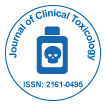
Journal of Clinical Toxicology
Open Access
ISSN: 2161-0495

ISSN: 2161-0495
Commentary - (2025)Volume 15, Issue 2
Applied toxicology, a vital sub-discipline within toxicology, serves as the practical bridge between toxicological research and its realworld applications. While traditional toxicology investigates the adverse effects of chemical, physical or biological agents on living organisms, applied toxicology focuses on how this knowledge is used in medicine, pharmacology, environmental science, public health and regulatory affairs. As industrialization, globalization and chemical innovations surge, applied toxicology has never been more crucial in safeguarding human and environmental health.
One of the primary focuses of applied toxicology is risk assessment. This process evaluates the potential health risks posed by exposure to hazardous substances, such as pesticides, industrial chemicals, food additives, or pharmaceutical agents. The field encompasses hazard identification, dose-response assessment, exposure assessment and risk characterization. Through this comprehensive approach, applied toxicologists contribute to setting safety limits, such as acceptable daily intakes (ADIs) or Occupational Exposure Limits (OELs), which form the backbone of regulatory decision-making across countries.
Pharmaceutical and clinical toxicology form another critical application. Before any drug is approved for human use, it undergoes a battery of toxicological tests to evaluate its safety. Applied toxicologists design and interpret preclinical studies using in vitro and in vivo models to determine potential organ toxicity, carcinogenicity, reproductive effects and more. Postmarketing surveillance also falls under applied toxicology, ensuring that once a drug reaches the market, any unforeseen adverse effects are monitored and managed through pharmacovigilance programs.
Environmental toxicology, a branch of applied toxicology, examines how pollutants affect ecosystems and human populations. With increasing environmental contamination be it air pollution, waterborne toxins or microplastics applied toxicologists are essential in identifying sources of exposure and mitigating harm. Tools like biomonitoring and ecotoxicological models help predict long-term outcomes, assisting governments in creating policies for sustainable environmental management.
Occupational toxicology is another vital application, especially relevant in the context of industrial workers exposed to chemicals, solvents or heavy metals. Applied toxicologists play a pivotal role in evaluating workplace safety, recommending protective measures and formulating guidelines to reduce occupational illnesses.
Recent advances in applied toxicology also incorporate cuttingedge technologies such as omics (genomics, proteomics, metabolomics), Artificial Intelligence (AI) and computational toxicology. These tools enhance our understanding of toxicity pathways and improve predictive models, reducing the need for animal testing while increasing precision in safety assessments. The integration of in silico models and high-throughput screening is revolutionizing the way we evaluate chemical safety, providing rapid and cost-effective alternatives.
Despite its scientific rigor, applied toxicology also faces challenges. The complexity of chemical mixtures, inter-individual variability in response and the emergence of new synthetic compounds demand constant evolution of methodologies and regulatory frameworks. Moreover, there is a growing need for interdisciplinary collaboration between toxicologists, clinicians, environmental scientists and policymakers to ensure that findings are translated effectively into public health protections.
In conclusion, applied toxicology is a cornerstone of modern public health and safety. By translating complex toxicological data into practical applications, it enables informed decisions that protect people and the environment. As our world becomes increasingly complex and chemically diverse, the role of applied toxicology will continue to expand, demanding innovation, vigilance and cross-sector cooperation. The discipline stands not only as a safeguard but also as a proactive force in promoting sustainable and safe development in the 21st century.
Citation: Rahman AN (2025). Scientific Foundations for Chemical Safety and Regulation. J Clin Toxicol. 15:588.
Received: 03-Mar-2025, Manuscript No. JCT-25-37523; Editor assigned: 06-Mar-2025, Pre QC No. JCT-25-37523 (PQ); Reviewed: 20-Mar-2025, QC No. JCT-25-37523; Revised: 27-Mar-2025, Manuscript No. JCT-25-37523 (R); Published: 07-Apr-2025 , DOI: 10.35248/2475-3181.25.15.588
Copyright: © 2025 Rahman AN. This is an open-access article distributed under the terms of the Creative Commons Attribution License, which permits unrestricted use, distribution, and reproduction in any medium, provided the original author and source are credited.